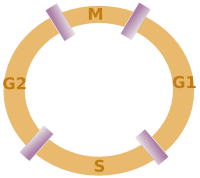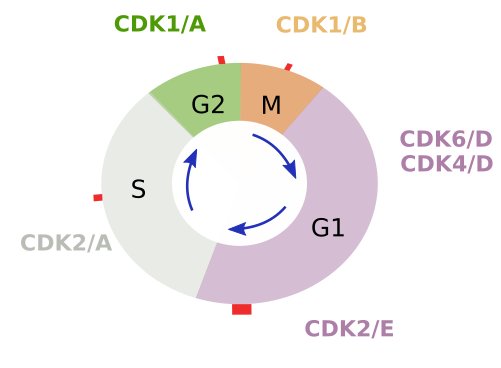Whether a cell is going to divide or not, and how many times, is a decision regulated in most pluricellular organisms. This control is necessary to reach a proper body size for a particular species. It is remarkable that cells of a whale is similar to cells of a sardine, but the whale has more cells. It is also important for the relative size of each body organ. For example, cells of the left limb must divide a similar number of times than the cells of the right limb, otherwise one limb would be larger than the other. In addition, cell of those tissues with a high turnover are under a basal and physiological division rate, like blood and epidermal cells.
In each division, a dividing cell go through four stages or phases: G1, S, G2 and M (Figure 1). G means gap or interval, S means synthesis and M means mitosis. Cell grows during G1 and G2 phases and gets everything ready for next phase. Some cells quit the cell cycle in G1 to differentiate, to remain quiescent, aging, or other reasons. Some of these cells may return to the cell cycle and proliferate again. DNA is replicated during S phase. Cell division happens during M phase, which includes mitosis (chromosoma formation and segregation between the two daughter cells) and cytokinesis (cytoplasm division).

Figure 1. Cell cycle phases in eukaryote cells. Interphase includes G1, S and G2 phases.
1. Checkpoints
At certain points of the cell cycle, there are checkpoints, which are molecular complexes that allows or not the progression of the cell cycle. They make sure that everything is correct to successfully accomplish the next phase. If there is something missing or something went wrong, checkpoint stop cell cycle progression.
Expression of new genes and activation of already present proteins needed for the next phase happen when a checkpoint is passed. Inactivation or removing some active proteins is also needed, mostly by ubiquitination (see below). There are about 100 genes showing a cyclic expression, that is, their concentration peaks at some point of the cell cycle, that are involved in checkpoints. Cyclins are one of them.
Position
There are several important checkpoints in the cell cycle (Figure 2).

Figure 2. Main checkpoints in the cell cycle.
a) At the end of G1, and before entering S phase, there is a very restrictive checkpoint. So strict that is known as restriction point. If this point is passed, the cell cycle progresses independently of any external signal. However, many intracellular tasks have to be accomplished and some extracellular stimuli are also needed to pass the restriction point. This point is so crucial because the DNA is going to be replicated during the next S phase, and it should be carried out with all the guaranties.
b) During S phase, there is a checkpoint controlling that DNA replication is going properly, meaning that all DNA must be replicated and it must be done without mistakes.
c) At the end of G2 phase, another checkpoint decides to enter or not in M phase. Cells need to grow enough and have everything prepared for condensing chromatin into chromosomes and building the spindle pole.
d) In M phase, there is a checkpoint at the transition from metaphase to anaphase making sure that the segregation of chromosomes between the two daughter cells will be correct.
CDKs: Cyclin-dependent kinases
Cyclin-dependent kinases (CDKs) are key enzymes working at the checkpoints. Active CDKs help to pass checkpoints by phosphorylating a wide variety of molecules. Of course, CDKs activity is tightly regulated and many fulfilled requirements are needed for the activation. There are about 20 CDKs in eukaryote cells, but only 1, 2, 4 and 6 CDK are related to the cell cycle. CDK4 and CDK6 work during G1 phase. CDK7 activates CDK4 and CDK7, and CDK3 allows cell to return to G1 after they exit cell cycle. Each CDK is activated in a particular phase of the cell cycle and some CDKs are activated is specific tissues. To be activated, CDKs need to be associated with cyclins. In addition, the activation depends in turn on the activity of other kinases and phosphatases that add or remove phosphate groups from CDKs. Finally, there is an array of proteins that inhibit the CDK activity, even when all the other requirements are properly fulfilled.
It looks like that a cell does not strictly need such a wide variety of CDKs, and that there is redundancy in their roles, that is, one CDK may take over the function of other missing CDK. For example, CDK1 is able to replace all the other CDKs during the early embryo development in mice. The same happens in yeast cells. However, a large array of CDKs may provide a more versatile cell cycle and a better response to a diversity of extracellular signals.
Cyclins
Cyclins are proteins synthesized and degraded during specific phases of the cell cycle (Figure 3). It means that there is a high concentration of a particular cyclin during a specific phase of the cell cycle, and therefore it is possible to activate a particular CDK at that precise moment. Each cyclin activates specific CDKs: cyclin A and B activate CDK1, A, B and C activate CDK2, cyclin D activate CDK4 and CDK6.

Figure 3. Different CDK + cyclin (CDK/Cyclina) complexes are functional at specific phases of the cell cycle.
Degradation. Ubiquitin. APC/C
Ubiquitin is an evolutionary conserved protein present in eukaryote cells. Ubiquitin can be chemically linked to other proteins, which is a signal for degrading those proteins. Cyclin degradation during the cell cycle is mediated by several proteins complexes. APC/C is a protein complex that promotes the ubiquitination of cyclins at certain moments of the cell cycle and targeted them for degradation.
Internal and external signals
Internal and external signals determine if a cell is going to divide or not. Some internal signals like DNA damages, small cell size, lacking molecules necessary for the next phase, and not appropriate telomere length, inhibit the progression of the cell cycle. This inhibition usually happens at the checkpoints.
A healthy cell divides after sensing specific external stimuli or signals. The signals are usually proteins released by other cells, and can be classified as mitogens, growth factors, and survival factors. Each with roles in different aspects of the cell cycle progression. If they are not present, cells do not pass the G1/S restriction point.
It is currently accepted that cell size depends on intracellular and extracellular variables. For example, during G1 phase, CDK4 is thought to be involved in controlling cell size by influencing the length of the G1 phase. In other words, the length of the cell cycle and cell size are related between each other.
Embryonic stem cells show a shorter cell cycle. They can proliferate very fast, which is feature of undifferentiated cells. In adult stem cells, there is no oscillation of the synthesis/degradation rate of cyclins, excepting cyclin E, Cyclin A is needed for maintaining the proliferative behavior, CDK2 is always active, and retinoblastoma protein is phosphorylated (inhibited). As cells progressively restrict their differentiation potential, the cell cycle gets longer, the cyclins synthesis/degradation rate begins to oscillate, other oscillatory molecules establish their periodicity, and checkpoints start to be functional. The longer cell cycle is mostly due to a longer G1 phase.
Cancer cells bear many mutations that lead checkpoint to be non-functional. Many mutations are needed to get a cancer cell because, as we said above, many regulatory molecular pathways converge in the checkpoints. There are two types of genes that are mutated: oncogenes and tumor suppressor genes. Oncogenes promote cell cycle progression and tumor suppressor genes inhibit cell cycle.
Bibliography
Brown A, Geiger H. 2018. Chromosome integrity checkpoints in stem and progenitor cells: transitions upon differentiation, pathogenesis, and aging. Cellular and molecular life sciences 75:3771–3779.
Kernan J, Bonacci T, Emanuele MJ. 2018. Who guards the guardian? Mechanisms that restrain APC/C during the cell cycle. BBA - Molecular Cell Research. 1865: 1924–1933.
Hernández-Carralero E, Cabrera E, Alonso-de Vega I , Hernández-Pérez S, Smits VAJ, Freire R. 2018. Control of DNA Replication Initiation by Ubiquitin. Cells 7, 146; doi:10.3390/cells7100146.
Zaveri L, Dhawan, J. 2018. Cycling to meet fate: connecting
pluripotency to the cell cycle. Frontiers in cell and development biology. 6, 146
.